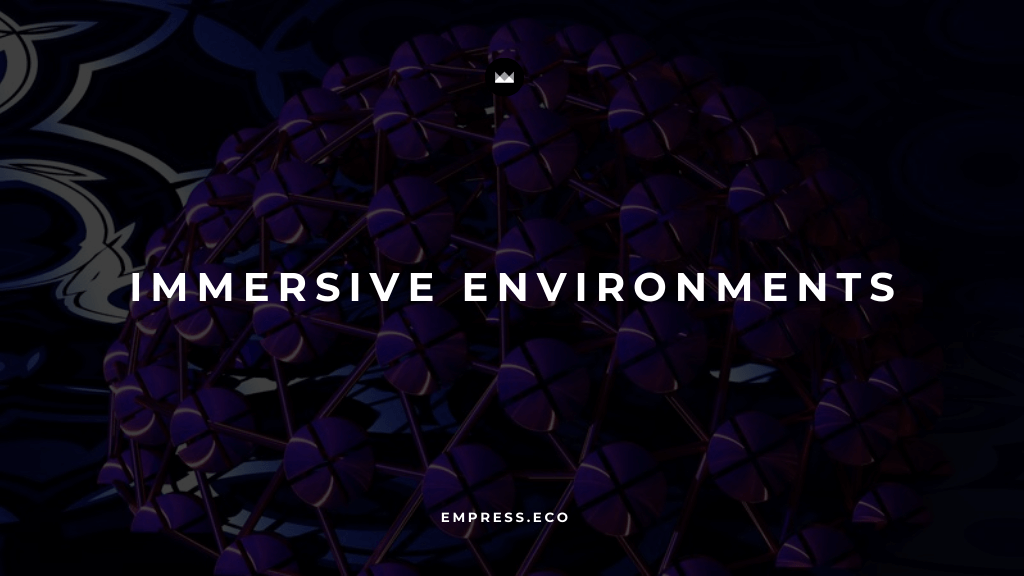
Experience Design: Creating Immersive, Captivating Environments for Audiences
Table of Contents
When consumer attention is fragmented and competition is fierce, simply offering a product or service is no longer enough. To truly engage your audience and build lasting relationships, you need to create experiences that captivate and immerse them in your brand's world. This is where experience design comes into play.
Experience design is the art and science of creating environments that engage the senses, evoke emotions, and foster connections between your brand and your audience. It goes beyond traditional marketing by focusing on how people interact with your brand in a physical or digital space, ensuring that every touchpoint is designed to be memorable, meaningful, and impactful.
Why Experience Design Matters
In an age where consumers are bombarded with information and choices, experience design offers a way to cut through the noise. By crafting immersive environments that capture attention and encourage active participation, brands can create deeper connections with their audiences, foster loyalty, and stand out in a crowded market.
But why is experience design so powerful? Let’s explore the key benefits.
Key Benefits of Experience Design
1. Enhanced Audience Engagement
One of the primary benefits of experience design is its ability to enhance audience engagement. Traditional advertising often relies on passive consumption—audiences watch a commercial, read an ad, or scroll through a social media post. Experience design, on the other hand, invites audiences to actively participate in the brand’s world.
Here’s how enhanced engagement works:
- Active Participation: When audiences are actively engaged, they’re more likely to form a connection with the brand. For example, a pop-up shop that allows visitors to interact with products in a hands-on way will likely leave a stronger impression than a traditional retail display.
- Immersive Environments: By creating environments that fully immerse the audience—whether through physical spaces, digital platforms, or a combination of both—brands can capture attention more effectively. Immersive environments encourage audiences to explore, interact, and engage with the brand on a deeper level.
For example, consider how brands like IKEA design their stores not just as places to buy furniture, but as immersive environments where customers can visualize and interact with products in a way that mirrors their own homes. This approach not only enhances engagement but also makes the shopping experience more enjoyable and memorable.
2. Memorable Brand Experiences
Creating memorable brand experiences is another crucial benefit of experience design. In a world where consumers are constantly bombarded with information, creating a lasting impression is key to building brand loyalty.
Here’s how experience design creates memorable moments:
- Creating Lasting Impressions: Well-designed experiences leave a lasting memory in the minds of consumers. Whether it’s the excitement of exploring a themed environment, the surprise of an unexpected interaction, or the satisfaction of completing a hands-on activity, these experiences stay with the audience long after the event is over.
- Positive Associations: Memorable experiences often lead to positive associations with the brand. When consumers recall these experiences, they are likely to feel a sense of connection and loyalty to the brand, which can influence future purchasing decisions.
For instance, Disneyland isn’t just a theme park; it’s an immersive experience where every detail, from the rides to the food to the customer service, is designed to create lasting memories for visitors. These positive experiences reinforce the Disney brand and foster lifelong loyalty among its audience.
3. Increased Emotional Connection
Experience design is also incredibly effective at building emotional connections with your audience. When designed thoughtfully, experiences can evoke powerful emotions that resonate with consumers on a deeper level.
Here’s how experience design builds emotional connections:
- Multi-Sensory Engagement: By engaging multiple senses—sight, sound, touch, and even smell—experience design can create a more immersive and emotionally resonant experience. For example, a fragrance company might use scent diffusers in a pop-up shop to create an environment that not only showcases their products but also evokes specific emotions and memories in visitors.
- Storytelling through Design: Storytelling is a powerful way to evoke emotions, and when integrated into experience design, it can create a narrative that audiences connect with on an emotional level. For example, a brand might design an event that takes visitors on a journey, with each stage of the experience revealing a new chapter in the brand’s story.
Consider how Apple’s retail stores are designed not just as places to buy products, but as spaces where customers can explore, learn, and experience the brand’s ethos of innovation and creativity. The minimalist design, hands-on product displays, and knowledgeable staff all contribute to an environment that fosters a deep emotional connection with the brand.
4. Differentiation in the Market
In a crowded marketplace, experience design offers a way to differentiate your brand from competitors. By creating unique and captivating experiences, you can attract attention and stand out in ways that traditional marketing methods may not achieve.
Here’s how experience design drives differentiation:
- Unique Brand Experiences: Experience design allows brands to create one-of-a-kind environments that are unique to them. Whether it’s a branded event, a pop-up shop, or an interactive online platform, these experiences can set your brand apart from the competition.
- Innovative Use of Technology: By leveraging cutting-edge technologies such as Augmented Reality (AR), Virtual Reality (VR), and interactive displays, brands can create experiences that are not only unique but also highly engaging. These innovations can position your brand as forward-thinking and innovative, further differentiating you from competitors.
For example, the fashion brand Burberry has used experience design to differentiate itself by creating a flagship store in London that blends physical and digital experiences. The store features interactive mirrors that transform into screens displaying exclusive content, creating a shopping experience that’s both unique and immersive.
Implementing Effective Experience Design
Now that we’ve explored the benefits of experience design, let’s dive into how you can implement it effectively. Creating immersive and captivating environments requires a thoughtful approach that considers your audience, leverages technology, and engages multiple senses.
Step 1: Understand Your Audience
The first step in implementing effective experience design is to understand your audience. Knowing who your audience is, what they care about, and how they interact with your brand is crucial for designing experiences that resonate.
Here’s how to understand your audience:
- Conduct Thorough Research: Use surveys, focus groups, and data analytics to gather insights into your audience’s preferences, behaviors, and expectations. Understanding what motivates them, what challenges they face, and what excites them will help you tailor the experience to meet their needs.
- Segment Your Audience: Different segments of your audience may have different needs and preferences. By segmenting your audience, you can design experiences that are more personalized and relevant to each group. For example, a technology company might create different experiences for early adopters versus mainstream users.
- Create Audience Personas: Develop detailed personas that represent your key audience segments. These personas should include demographic information, interests, pain points, and preferred communication channels. Use these personas to guide your experience design decisions.
For example, if your audience consists of tech-savvy millennials who value convenience and innovation, you might design an experience that leverages mobile technology and offers a seamless, app-driven interaction.
Step 2: Leverage Technology
Technology plays a crucial role in modern experience design. By incorporating cutting-edge technologies into your environments, you can create dynamic and engaging experiences that captivate your audience.
Here’s how to leverage technology in experience design:
- Augmented Reality (AR): AR allows you to overlay digital content onto the physical world, creating interactive experiences that blend the real and virtual. For example, a furniture retailer might use AR to let customers visualize how products would look in their homes.
- Virtual Reality (VR): VR immerses users in a fully digital environment, providing a sense of presence and engagement that’s hard to achieve with other media. Brands can use VR to create immersive experiences that transport users to new worlds or allow them to explore products in a virtual space.
- Interactive Displays: Touchscreens, motion sensors, and other interactive technologies can create engaging, hands-on experiences. For example, an automotive brand might use interactive displays at a car show to let visitors customize a vehicle and see the results in real-time.
- Mobile Integration: With the ubiquity of smartphones, integrating mobile technology into your experience design can enhance engagement. For example, a retail store might use a mobile app to offer personalized recommendations and interactive in-store navigation.
For instance, Sephora has effectively leveraged AR technology with its “Virtual Artist” app, which allows users to try on makeup virtually using their smartphone camera. This innovative use of technology not only enhances the shopping experience but also drives engagement and sales.
Step 3: Design for Multi-Sensory Engagement
Engaging multiple senses is a powerful way to create a more immersive and memorable experience. The more senses you engage, the more impactful the experience will be.
Here’s how to design for multi-sensory engagement:
- Visual Design: The visual aspect of your environment is crucial. Use colors, lighting, and imagery that reflect your brand and create the desired atmosphere. For example, a luxury brand might use soft lighting and rich colors to create an environment that feels exclusive and sophisticated.
- Soundscapes: Sound can significantly enhance the mood and atmosphere of an environment. Consider using background music, sound effects, or even silence to create the desired emotional impact. For example, a wellness brand might use calming sounds, like running water or soft music, to create a relaxing environment.
- Tactile Elements: Touch is a powerful sense that can make an experience more engaging. Consider incorporating tactile elements, such as different textures or interactive objects, that invite the audience to physically interact with the environment.
- Scent and Taste: While less common, scent and taste can be incredibly impactful senses to engage. For example, a bakery might use the scent of freshly baked bread to draw customers in, or a food brand might offer samples to engage the sense of taste.
An excellent example of multi-sensory experience design is the SENSORY4™ technology used in the Van Gogh Alive exhibit. The exhibit combines sight, sound, and movement to create an immersive experience that brings the artist’s work to life, engaging visitors on multiple levels and creating a memorable experience.
Step 4: Tell a Compelling Story
Storytelling is at the heart of effective experience design. A compelling narrative can guide the audience through the experience, making it more engaging and meaningful.
Here’s how to incorporate storytelling into your experience design:
- Create a Narrative Arc: Just like any good story, your experience should have a beginning, middle, and end. Start by introducing your audience to the environment and setting the stage for what’s to come. Build engagement through interactive elements or challenges, and conclude with a memorable takeaway that reinforces your brand’s message.
- Use Characters and Themes: Incorporate characters, whether real or imagined, to guide the audience through the experience. Themes can also help tie the experience together, making it more cohesive and impactful.
- Integrate Brand Values: Ensure that the story you’re telling aligns with your brand’s values and mission. Every element of the experience should reinforce the core message you want your audience to take away.
For example, the Guinness Storehouse in Dublin is designed as a journey through the history and brewing process of Guinness beer. Each floor of the building tells a different part of the brand’s story, culminating in a rooftop bar where visitors can enjoy a pint of Guinness with a view of the city. This immersive experience not only engages visitors but also reinforces the brand’s rich heritage and craftsmanship.
Step 5: Encourage Interaction and Participation
Interaction and participation are key to making an experience more engaging and memorable. By encouraging your audience to actively participate, you can create a sense of ownership and involvement that deepens their connection with your brand.
Here’s how to encourage interaction and participation:
- Design Interactive Elements: Incorporate elements that invite the audience to interact with the environment, such as touchscreens, motion sensors, or physical activities. For example, a museum might use interactive displays that allow visitors to explore exhibits in more depth.
- Create Challenges or Games: Gamification can be a powerful tool for increasing engagement. Consider incorporating challenges or games that encourage the audience to explore the environment and interact with your brand. For example, a retail store might create a scavenger hunt that leads customers to different sections of the store, offering rewards along the way.
- Offer Personalization: Personalization can make the experience feel more relevant and engaging. For example, a clothing brand might offer a customization station where customers can personalize their purchases, creating a unique and memorable experience.
For example, at the Heineken Experience in Amsterdam, visitors are invited to participate in interactive exhibits that simulate the brewing process, allowing them to feel like they’re part of the Heineken story. This level of participation makes the experience more engaging and memorable, fostering a deeper connection with the brand.
Challenges and Considerations in Experience Design
While experience design offers numerous benefits, it also comes with its own set of challenges. Understanding these challenges and planning accordingly is essential for successful implementation.
1. Resource Intensive
Experience design can be resource-intensive, requiring significant investment in time, budget, and expertise. Creating an immersive environment often involves complex logistics, cutting-edge technology, and specialized skills.
To manage resources effectively:
- Set Clear Objectives: Define what you want to achieve with the experience. Having clear objectives will help you allocate resources more effectively and focus on what matters most.
- Plan and Budget: Develop a detailed plan that outlines the steps involved in creating the experience, along with a realistic budget. Factor in costs for technology, materials, labor, and unexpected expenses.
- Leverage Partnerships: Consider partnering with other brands, sponsors, or vendors to share the cost and resources involved in creating the experience. Collaboration can also bring additional expertise and creativity to the project.
2. Balancing Innovation and Accessibility
While innovation is key to creating a standout experience, it’s also important to ensure that the experience is accessible to all audience members. This includes considering factors such as physical accessibility, language barriers, and technological proficiency.
To ensure accessibility:
- Design for Inclusivity: Consider the needs of different audience segments, including those with disabilities. Ensure that the environment is physically accessible and that all elements are easy to navigate and interact with.
- Provide Multiple Entry Points: Offer different ways for the audience to engage with the experience. For example, if the experience involves advanced technology, provide alternatives for those who may not be comfortable using it.
- Test and Iterate: Before launching the experience, conduct testing with diverse groups to identify any accessibility issues. Use the feedback to make necessary adjustments and ensure that the experience is inclusive.
3. Measuring Impact
Evaluating the effectiveness of experience design can be challenging, especially when it comes to measuring intangible outcomes like emotional connection and brand perception.
To measure the impact of your experience design:
- Set Clear Metrics: Define the metrics that matter most for your objectives. This might include engagement rates, social media mentions, customer feedback, or sales conversions.
- Gather Feedback: Use surveys, interviews, and social media listening tools to gather feedback from participants. Understand what they liked, what they didn’t, and how the experience impacted their perception of the brand.
- Analyze Data: Use analytics tools to track interactions, engagement levels, and other relevant data. This can help you identify patterns and understand which elements of the experience were most effective.
Conclusion: The Power of Experience Design
Experience design is a powerful tool for businesses looking to create immersive and captivating environments that engage audiences on a deeper level. By leveraging technology, storytelling, and multi-sensory engagement, companies can create memorable experiences that foster strong emotional connections and drive brand loyalty.
In summary:
- Enhanced audience engagement is achieved through active participation and immersive environments that capture attention and encourage interaction.
- Memorable brand experiences leave a lasting impression on consumers, making the brand more memorable and fostering positive associations.
- Increased emotional connection is built through multi-sensory engagement and storytelling, creating a deeper resonance with the audience.
- Differentiation in the market is driven by unique and innovative experiences that set the brand apart from competitors.
By following the steps outlined in this guide—understanding your audience, leveraging technology, designing for multi-sensory engagement, telling a compelling story, and encouraging interaction—you can create experiences that not only captivate your audience but also drive long-term success for your brand. As the marketing landscape continues to evolve, experience design will be essential for businesses seeking to maintain a competitive edge and achieve lasting growth.
Empress Newsletter
Join the newsletter to receive the latest updates in your inbox.



